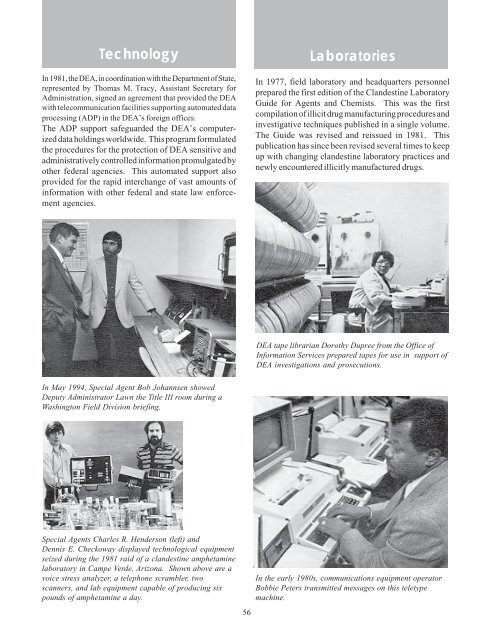Download This File - The Free Information Society
Download This File - The Free Information Society
Download This File - The Free Information Society
You also want an ePaper? Increase the reach of your titles
YUMPU automatically turns print PDFs into web optimized ePapers that Google loves.
Technology Laboratories<br />
In 1981, the DEA, in coordination with the Department of State,<br />
represented by Thomas M. Tracy, Assistant Secretary for<br />
Administration, signed an agreement that provided the DEA<br />
with telecommunication facilities supporting automated data<br />
processing (ADP) in the DEA’s foreign offices.<br />
<strong>The</strong> ADP support safeguarded the DEA’s computerized<br />
data holdings worldwide. <strong>This</strong> program formulated<br />
the procedures for the protection of DEA sensitive and<br />
administratively controlled information promulgated by<br />
other federal agencies. <strong>This</strong> automated support also<br />
provided for the rapid interchange of vast amounts of<br />
information with other federal and state law enforcement<br />
agencies.<br />
In May 1994, Special Agent Bob Johannsen showed<br />
Deputy Administrator Lawn the Title III room during a<br />
Washington Field Division briefing.<br />
Special Agents Charles R. Henderson (left) and<br />
Dennis E. Checkoway displayed technological equipment<br />
seized during the 1981 raid of a clandestine amphetamine<br />
laboratory in Campe Verde, Arizona. Shown above are a<br />
voice stress analyzer, a telephone scrambler, two<br />
scanners, and lab equipment capable of producing six<br />
pounds of amphetamine a day.<br />
56<br />
In 1977, field laboratory and headquarters personnel<br />
prepared the first edition of the Clandestine Laboratory<br />
Guide for Agents and Chemists. <strong>This</strong> was the first<br />
compilation of illicit drug manufacturing procedures and<br />
investigative techniques published in a single volume.<br />
<strong>The</strong> Guide was revised and reissued in 1981. <strong>This</strong><br />
publication has since been revised several times to keep<br />
up with changing clandestine laboratory practices and<br />
newly encountered illicitly manufactured drugs.<br />
DEA tape librarian Dorothy Dupree from the Office of<br />
<strong>Information</strong> Services prepared tapes for use in support of<br />
DEA investigations and prosecutions.<br />
In the early 1980s, communications equipment operator<br />
Bobbie Peters transmitted messages on this teletype<br />
machine.

















